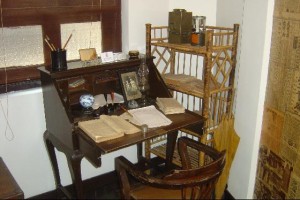
1920’s and 1930’s was the time of money, trade and parties in Shanghai, it was also a time for an incredible development of arts. While businesses where embracing new trades and industries coming from the West and introducing them to China with great profits, artists were also feeling the western wind. Jesuits fathers created a painting in school in Xu Jia Hui which was influential in introducing western painting styles and techniques to Chinese artists. At the same time, many Chinese writers came to settle in Shanghai to benefit from the commercial opportunities, safety and freedom allowed by the foreign concessions. This mostly poor crowded was often living in a “Tingzidian”, a small room between two main floors rented out in a lane house (see picture). Mostly northward looking and of very small size, tingzidian were not the most comfortable room of the house but they allowed those artists to leave in a central location at a low price. Just like French litterature from the late 19th and early 20th century was written in the Paris cafes and the “Chambre de bonne” (rooms on the top of buildings with little comfort where many artists lived and wrote), Shanghai litterature was written in the cafes of Huai Hai Lu and the French Concession, as well as in the tingzidian. Young artists would spend hours in cafes, discussing litterature, painting and how to build a new world. This was the time when artists associations like the painters “Storm society” were formed, as well as writers magazines such as “Xiandai, Les Comptemporains”.
Progressive writers such as Mu Shiying, Shi Zecun and Le Ying Feng were among the main expressionists writers of this period. Shanghai Foxtrot from Mu Shiying is for me the best symbol of old Shanghai party life described by Chinese writers. Mu Shiying was a dandy and his stories are about dandy life, dancings, clubs and restaurant. He certainly lived the high life while in Shanghai and that makes this short story so enjoyable. The party period only last for a short time, but some of these artists certainly enjoyed it. Reading texts from the 1920’s and cruising through the night life of today’s Shanghai, one sometimes feels like an echo, a deja-vu feeling (see the post “Decadence on the Bund” for more on this).
The party lasted only for a few years, as by the middle of the 1930’s politics had taken over many artists. Most of them joined or sympathized with the communist party and art was used to carry the message to the masses. Many then entered the war or resistance against the Japanese occupation. Some other fled to Hong Kong, some collaborated with the Japanese authorities, often being assasinated because of this. The 1920’s was a the time for art and adventure, by the late 1930’s art had left the place for politics. The litterature of the time was forgotten for many years before being rediscovered in the 1990’s and being republished first in China and then abroad. I only found Shanghai Foxtrot in French and in English… and after some research in Chinese as a collection of Mu Shiying works was republished in 2004.